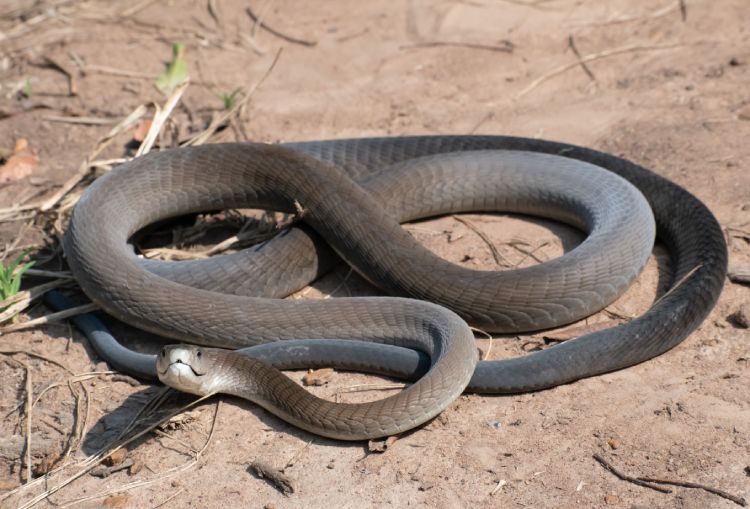10 of the Biggest Snakes in the World

Slithering over desert sands, through rainforests, and even across the ocean, snakes are one of nature’s most feared but also alluring species. With the oldest known snake fossil of the Eophis Underwoodi dating back 167 million years to the Bathonian stage of the Middle Jurassic, snakes have evolved in a multitude of ways to fit any and every biome on Earth. These evolutionary changes have manifested in many ways, but one of the most shocking is the sheer size of some serpents. Found across the globe, the world’s biggest snakes are a formidable force in their respective habitats. Let’s go down the list and acquaint ourselves with these serpentine giants!
10 King Brown – Up to 9.8 feet (3 meters)
Also called the “Mulga snake,” this venomous serpent is found throughout Australia, excluding the southeastern region, wetlands, and mountains. They typically have an average length of around 6 feet (1.8 meters) and weigh 6 – 13 lb. (3 – 6 kg), but some recordings indicate lengths of over 9 feet!
They have a small, flat head and a thick body with smooth scales in a shade of brown that varies according to their habitat. Their camouflage is excellent to hide from threats but poses a danger to other animals in the area. The king brown is a part of the Elapidae, so it’s a relative of the famous cobras. While they lack the hood common among cobras, they do share the same neurotoxic and anticoagulating properties in their venom. (1, 2)
9 Black Mamba – Up to 14 feet (4.2 meters)
Found in the sub-Saharan region of Africa, the black mamba is one of the most dangerous snakes on the continent. Along with a lightning-quick strike and potent venom, the black mamba is also one of the fastest snakes in the world, reaching slithering speeds of 12.5 miles an hour (20 km/h). This speed is used to escape from threats, but it will also chase after animals and people when cornered.
When this snake bites, it does so quickly and repeatedly. Even two drops of black mamba venom can be fatal for a human as it attacks the nervous system and the heart. However, there have been no recorded cases of unprovoked bites. The snake gets its name from its defense mechanism of opening its jaws and showing the black flesh of its mouth to appear more threatening to potential predators.
The black mamba has an average length of 7.2 – 8.8 feet (2.2 – 2.7 meters). However, the longest recorded black mamba to date is 14 feet long (4.2 meters). Being fairly thin snakes, they have an average weight of 3.5 lb. (1.5 kg). (1, 2)
8 Central African Rock Python – Up to 16 feet (5 meters)
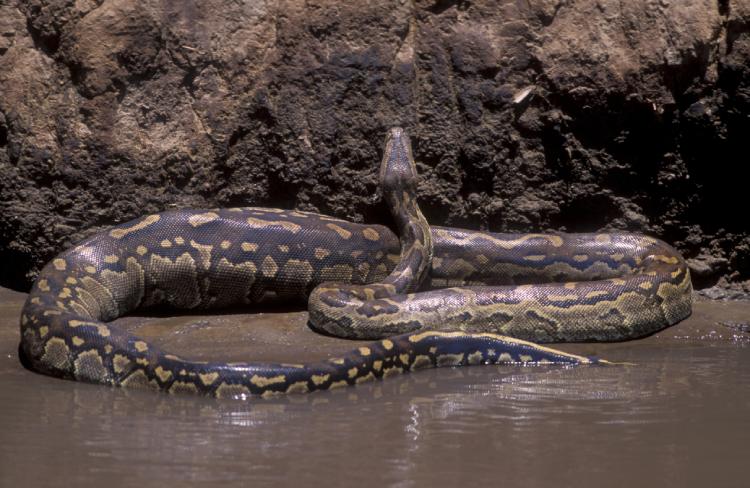
As the name suggests, this snake can be found in the central and southern grasslands of Africa. It has a long triangular head, a sturdy body, and a short tail. It is typically found in shades of dark brown with light-brown blotches, but there are some with very different coloration as well.
One of the world’s biggest snakes, these constrictors hunt their prey of mammals and birds by coiling their body around the animal before consuming it. Usually found in rock outcroppings on the savanna, Central African rock pythons also frequent streams, rivers, and lakes. While the average length of these snakes ranges from 9.8 – 16 feet (3 – 5 meters), one specimen from the Ivory Coast stood out from the rest by reaching 24 feet (7.5 meters). This earns it a spot amongst the world’s biggest snakes! These are also some heavy snakes, clocking in at an average of 121 lb. (55 kg). (source)
7 King Cobra – Up to 18 feet (5.4 meters)
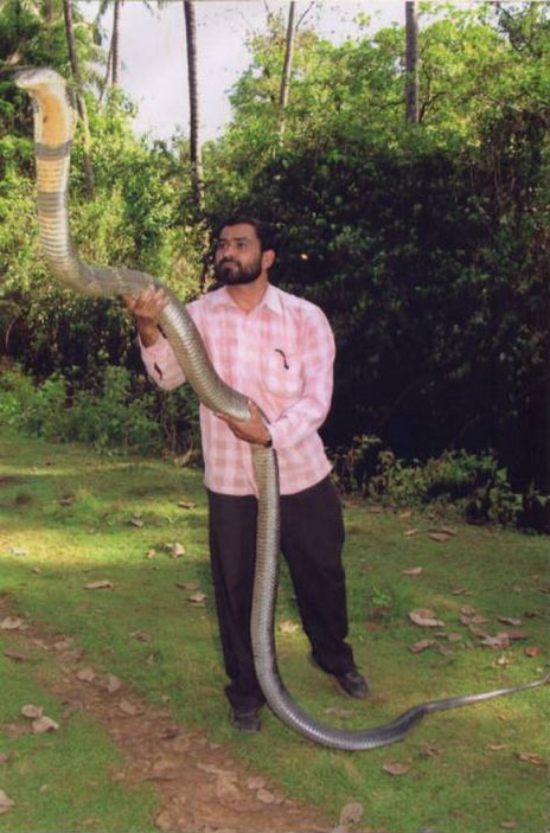
The name of this entrant is very apt; the King cobra is the world’s biggest venomous snake. Not only does it reach incredible sizes, but it also has the largest reserves of venom as compared to other snakes. King cobras can stand and flare their hoods like other cobras with one frightening twist; when a King cobra stands, it comes to the eye level of a person! Even with one-third of its body raised off the ground, the King cobra can still attack from this position.
These giants can be found in the rainforests and plains of India, Southern China, and Southeast Asia. The average adult will grow to be around 12 – 13 feet (7 – 4 meters) and weigh up to 20 lb. (9 kg). The longest one in the world was found to be a frightening 18.8 feet (5.71 meters), easily making it one of the world’s biggest snakes. These kings mainly eat other smaller snakes but will also hunt lizards, small mammals, and eggs of other animals. (1, 2, 3)
6 Cuban Boa – Up to 18.5 feet (5.65 meters)
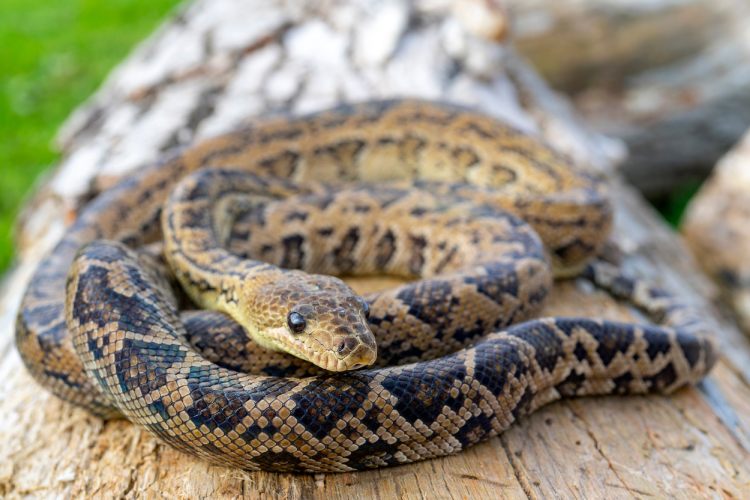
Dubbed the “Maja de Santa MarÃa†by the locals, the Cuban boa is native to Cuba and some nearby islands. While they typically reach lengths of 18.5 feet (5.65 meters), some have set records by growing more than 19.6 feet (6 meters). Another constrictor, this large snake is typically brown with a pattern of staggered dark brown rhombic spots.
Named one of Cuba’s top terrestrial predators, it hunts rodents, lizards, and birds. These snakes prefer to roam around in thick forests, but they have also been spotted hanging out in the trees after getting their 66 lb. (30 kg) bodies up into the branches. (source)
5 Indian Python – Up to 21 feet (6.4 meters)
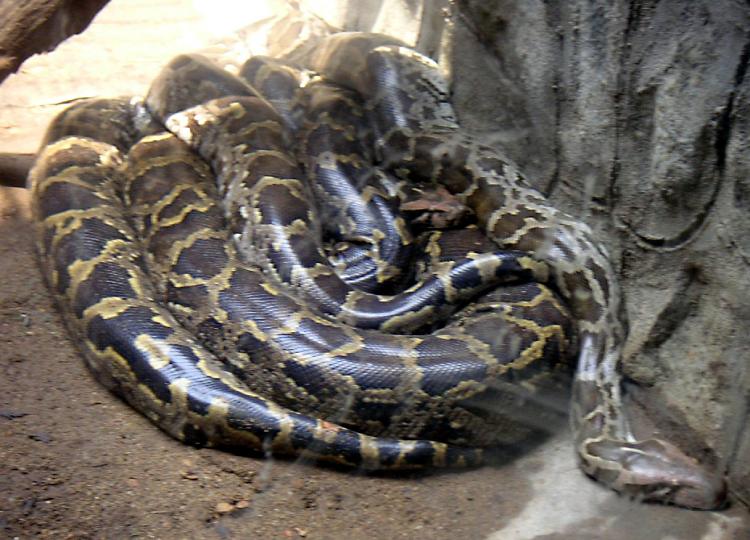
Inspiring the character of Kaa from Rudyard Kipling’s The Jungle Book, the Indian python is India’s biggest snake. Found in the lower half of the Asian continent, including areas of China, Malaysia, and even Borneo, they can reach weights of up to 200 lb. (90 kg) and lengths up to 21 feet (6.4 meters). This constrictor is at home in rainforests, river valleys, woodlands, scrublands, grassy marshes, and semi-rocky foothills. They are solitary creatures, subsisting on a diet of small mammals, birds, and other reptiles. Indian pythons are also expert swimmers, using the buoyancy of water to help move their immense size. ( 1, 2)
4 Burmese Python – Up to 23 feet (7 meters)

Slithering along the damp environments of Southeast Asian grassy marshes and jungles, we find the beautiful Burmese pythons. It’s little surprise this species is one of the world’s biggest snakes when they can weigh up to 200 lb. (90kg) with a body as thick as a telephone pole. On average, these snakes grow to a respectable 16 feet (4.8 meters) in length. However, there are some individuals who have grown over 23 feet (7 meters) too. During their early years, they spend their time in trees but become more ground-dwelling once they approach adulthood.
These snakes, just like the Central African rock python, are also constrictors, but they have one more surprise up their scales: chemical and heat receptors. These “sensors” are located on the tongue and along the jaw, respectively, making up for their poor eyesight when it comes to finding a meal. (source)
3 Amethystine Python – Up to 23 feet (7 meters)
This is what you call a whopper.
Amethystine python, Oz. pic.twitter.com/7PsFhaG3zs— danmcd 💚🇺🇦ðŸ´ó §ó ¢ó ³ó £ó ´ó ¿ (@DanielMcDonald4) May 3, 2019
Also called the “Scrub python,” these constrictors are native to the forests of Indonesia, New Guinea, and northern Australia. It has large symmetrical scales which can be found in a light yellowish to olive-brown color scale, with darker splotches on bands. In the sunlight, these scales dazzle onlookers with a beautiful blue-purple iridescence, which is where the snake got its name. It is an ambush predator, choosing to sit silently and wait for its prey, mainly mammals and birds, to wander by.
The average adult male weighs around 11 lb. (5.1 kg), while the females can reach up to 33 lb. (15 kg). They grow to be around 10 – 12 feet (3 – 3.7 meters) in length, and reports can be found of some exceeding even 23 feet (7 meters). (1, 2)
2 Reticulated Python – Up to 31.5 feet (9.6 meters)
This huge python casually wondering about
reticulated python (Malayopython reticulatus) is a python species native to South and Southeast Asia,
It is the world's longest snake,
pic.twitter.com/gvTWFLA3Nq— Science girl (@gunsnrosesgirl3) September 5, 2023
These snakes are found from southeastern Asia and western Bangladesh to southeastern Vietnam and on the Indo-Pacific islands west of New Guinea. Usually reaching a modest 15 feet (4.7 meters) in length, some absolute units have been recorded at a staggering 31 feet (9 meters). A few individuals have also reached an immense 595 lb. (270 kg) in weight, making them not just one of the longest but also one of the heaviest snakes in existence.
Due to their immense size, they are found around sources of water, which can help them move around their environment. While they typically feed on smaller mammals and birds, there have been reports of even sun bears becoming their prey. (1, 2)
1 Green Anaconda – Up to 39 feet (12 meters)
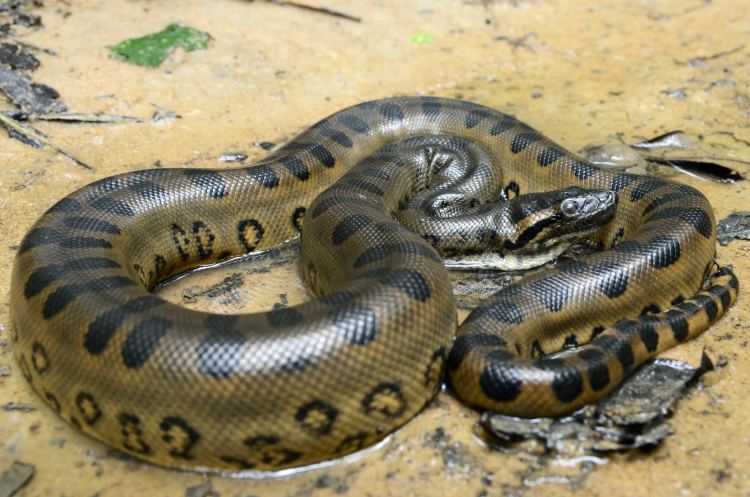
While Hollywood may have portrayed this snake in a variety of ways, the reality isn’t that far from screen magic. Going toe-to-toe with the reticulated python in length, the Green anaconda can outclass it in weight, with many reaching over 550 lb. (250 kg), making it the heaviest snake in the world. Given their enormous size, they are semi-aquatic but also slither their massive bodies across the rainforest floor in search of food.
They are an apex predator throughout the tropical lowlands of South America, hunting almost anything they can swallow. While they go after the standard fare of fish, mammals, and birds, they have also been known to hunt caimans and even jaguars! After all, they don’t become the world’s biggest snakes by eating small fish. Slithering around at an average length of 20 – 30 feet (6 – 9 meters) can be a challenge for these giants, but some 39-footers (12 meters) have also been discovered! (1, 2, 3)














